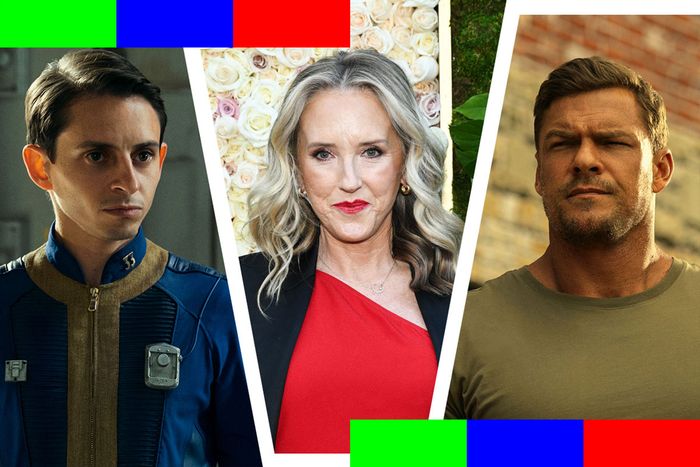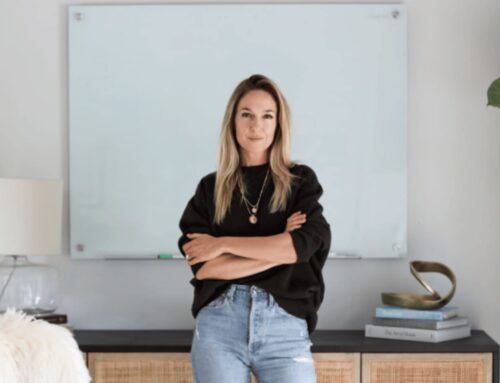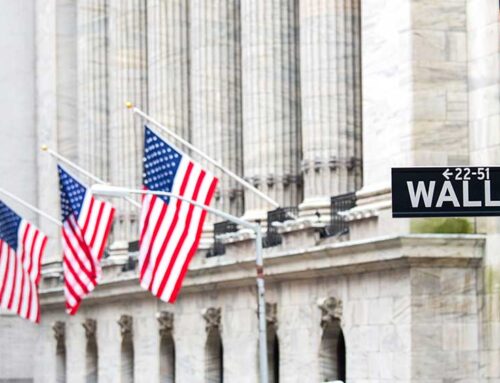Jen Salke’s Exit Won’t Fix Amazon’s Prime Video Problem
April 4, 2025
Jen Salke’s Exit Won’t Fix Amazon’s Prime Video Problem
Things you buy through our links may earn Vox Media a commission.
2:02 P.M.

Former Amazon MGM boss Jennifer Salke was stuck in a streaming identity crisis that traces back to Seattle, not Hollywood.
Photo-Illustration: Vulture; Photos: Prime Video (JoJo Whilden, Jasper Savage), Michael Buckner/GG2025/Penske Media via Getty Images
It was July 2018, and Jen Salke — barely five months into her new gig running Amazon Studios — found herself sitting on a ballroom stage in Beverly Hills gamely taking questions from a roomful of reporters, myself included, gathered for the semiannual TV Critics Association press tour. For about 30 minutes, Salke offered her thoughts on everything from the still-nascent Lord of the Rings series to a just-announced “global television franchise” she’d bought from the Russo brothers. When I got my chance to quiz Salke, I tried to get her on record about something a bit different: the dreadful state of Prime Video’s user interface — and specifically, whether she had heard of any plans to improve it.
Somewhat to my surprise, Salke not only agreed with my assessment (“I was on the side of criticizing that as well,” she said) but revealed that change was on the way. During a recent visit to Amazon HQ in Seattle, engineers had shown her a revamped Prime Video interface, one she said would be “much more intuitive” and greatly improve the user experience. Salke couldn’t say exactly when subscribers would see this spiffy new UI but promised it would be “coming soon.”
As it turned out, “soon” ended up being four full years: Prime Video’s long-anticipated UI upgrade wasn’t revealed until July 2022.
Last week, Salke’s seven-year run as head of Amazon Studios came to an abrupt end when she announced she would be transitioning to a production deal at the company. Speculation about why she was pushed out has centered on her handling of the company’s film business (especially the Bond franchise) or the perception that Amazon’s massive spending on TV projects hasn’t yielded enough game-changing hits for Prime. And yet when I heard the news about her ouster, my mind quickly went back to that 2018 TCA session and the sad saga of Prime’s user interface.
Not because that whole mishegoss played any sort of role in Salke’s exit. As big as her job at Amazon Studios was, it never included oversight of the product and engineering teams for Prime Video. That said, the fact that it took the length of an entire U.S. presidential term (and then some) to even begin to address such an important issue speaks volumes about the dysfunctional streaming universe in which Salke found herself operating. Unlike most other platforms with user-interface challenges (basically, everyone not named Netflix), Amazon is swimming in cash and has spent decades serving online consumers. It’s vocally a “customer-centric” tech company, through and through. Delivering a better user experience, and one which effectively showed off the series and movies Salke’s teams were making, should not have been a heavy lift. Amazon absolutely had the resources and engineering capability to come up with a user interface that works as smoothly and intuitively as Netflix’s does — if it wanted to.
But as anyone who’s spent time poking around the crowded digital aisles of the Prime Video app knows, that’s not what happened. Even after that 2022 redesign, and some subsequent tweaks, Amazon’s own original content often feels like a supporting player on the platform rather than the main attraction. My theory on why the app remains a hot mess, even with Amazon’s resources: This is what the folks at Amazon HQ in Seattle want. Despite all the billions Salke has been allowed to invest in programming, the Prime Video interface hasn’t really moved on from its original mission, which was to serve as Amazon’s hub for selling digital versions of other studios’ content. Original shows and movies are obviously important, but they’re not the lifeblood of Prime the way they are on Netflix or Max.
And that’s why, even today, subscribers opening up the Prime app will still often be greeted not with a promo for a new Amazon Studios–produced comedy or drama but with a pitch to subscribe to Paramount+ or rent a new movie from Sony or watch some crappy FAST channel. Sure, the overall scrolling experience is a bit better than before the 2022 redesign, and the biggest Prime Originals certainly get a push. But they’re at best a co-star on the platform rather than the main attraction. And while this setup is no doubt great for Amazon’s bottom line — the company gets a healthy cut when you sign up for Max or Acorn TV via Prime or when you rent a new release through the app — it’s a lousy way to build brand loyalty for your own streaming service, and it made it harder for Salke to get eyeballs on her projects. But more importantly, it underscores that what she and her team did was always competing with the priorities of other parts of the Amazon and Prime Video ecosystem.
None of this should be taken as some sort of blanket apologia for Salke’s tenure. Like any creative exec, she clearly had her flaws, particularly on the feature-film side of her portfolio. Consider: One of the key reasons Salke was hired away from NBC seven years ago was because she was known as a talent-friendly exec who knew how to massage the egos of the writers, actors, and producers who keep Hollywood running. But while she may have been able to do that on the TV side of the business, reporting from Deadline’s Mike Fleming and Puck’s Matt Belloni suggests she was less adept at managing movie talent, most notably the guardians of the James Bond franchise, and generally had little luck figuring out how to make movies work for Amazon. (If so, she’d be just one more TV-exec superstar who struggled with similar gigs in the film world — think Brandon Tartikoff and Gail Berman.) Meanwhile, The Ankler’s Lesley Goldberg this week talked to multiple sources who complained that Salke and her team, including day-to-day TV chief Vernon Sanders, took forever to develop and green-light projects, and even then the company often seemed to have a problem “knowing what it wanted” from creators, as Goldberg put it.
So, no, Salke is not leaving her gig running Amazon Studios universally beloved or the victim of some grave injustice from her bosses. But I think many of the complaints we’re seeing now about the Salke era at Amazon — including the Bond brouhaha and the underwhelming performance of The Lord of the Rings: The Rings of Power — are indictments of the larger dysfunction inside Amazon around what Prime Video should be and whose vision shapes the brand.
For example, one of Salke’s first big headaches upon arriving at Amazon was figuring out how to make LOTR work as a TV show. She faced this problem for one reason only: Amazon founder Jeff Bezos woke up one morning, decided Prime needed its Game of Thrones, overpaid for the rights to a property that had already been well exploited in feature films, then told someone else — Salke and Sanders — to make it all work. And even then, Salke had to manage competing company priorities (and possibly egos) when it came time to roll out the show.
Case in point: When HBO announced it was scheduling the launch of its much-anticipated Game of Thrones spinoff House of the Dragon on August 21, 2022, Amazon stubbornly decided to stick with its plan — announced a full year ahead of time — to debut Rings of Power less than two weeks later, on September 1. That move all but guaranteed the Amazon show would lose the war for attention among consumers because, as well known as Lord of the Rings is, GoT is the much newer, hotter property. The smart thing to do would have been to retreat and push back Rings of Power a few months. But that might have indicated Amazon wasn’t fully confident in Bezos’s baby and, what’s more, it would have messed up the synergies Amazon wanted to cook up between the show and the debut of Thursday Night Football on Prime. So the premiere date stayed, and a narrative — Rings of Power is a disappointment — was born.
Here’s the thing: While Salke had a ton of power as head of Amazon Studios, and no doubt some influence in how Prime Video ran, she did not have the same sort of clear mandate Dana Walden has running Disney+, ABC, and Hulu. Walden has bosses, sure — Bob Iger almost surely co-signs any checks with a nine-figure sum — but her word goes when it comes to both content and platform decisions. That’s not the case at Amazon. What’s worse, I’m not even sure Amazon has any desire to build a successful stand-alone streaming platform as much as it simply wants to find content of any kind that helps it sell more advertising and move more product across Amazon’s many e-commerce channels. That’s not necessarily a bad thing; YouTube has shown you don’t have to follow the Netflix or HBO or CBS templates to build a super-successful video service. But it’s not the kind of model best suited to an exec like Salke, a Hollywood vet raised to believe in things like brand identity and audience passion. In the end, her departure likely came because she simply stopped being as effective at servicing Amazon’s business model as her boss, Prime Video and Amazon MGM Studios chief Mike Hopkins, needed her to be.
Nonetheless, I would argue that overall, Salke’s seven-year stretch had more wins than losses — and that surviving so long in a company as brutal as Amazon (or, quite frankly, any Hollywood-exec suite) is itself an accomplishment. During her tenure, she helped Prime evolve from a fledgling producer of a handful of little-watched HBO Lite productions into a reliable purveyor of middlebrow, reasonably popular Content. That’s a compliment: In 2025, Amazon, a company that’s become a utility on par with water or electricity providers, does not need to be focusing its energies on winning the Quality TV wars. So while Salke obviously did make some plays for Emmys and maybe wasted some money doing so, in general, she brought a network-TV ethos to Prime, building on work started by her predecessors (she did not green-light The Boys) to make the platform the premier destination for Dad TV like Reacher, Cross, and Fallout. Given the investment Amazon has made in the NFL, that’s a pretty good lane to stake out.
Salke is also leaving Amazon Studios in better shape than she found it. A few months before Bezos tapped Salke to be his Hollywood player, The Wall Street Journal’s Ben Fritz and Joe Flint penned a blistering takedown of the company and then-leader Roy Price (the guy who would soon be pushed out in the wake of sexual-harassment allegations). “Where Amazon is Failing to Dominate: Hollywood,” the headline read. It chronicled the lack of global hits at Prime and the fading Emmys haul for its crop of prestige dramas while capturing internal disaffection over where the unit stood. As one Amazon Studios insider told the paper at the time, “We were supposed to bring the best practices of one of the most successful companies in America to Hollywood. Instead, we’re getting chewed up.” The story even got iconic producer David E. Kelley, who worked on the first season of Billy Bob Thornton’s Goliath for the streamer, to go on the record slamming Prime’s talent relations — or lack thereof. “Their entertainment division is a bit of a gong show,” he said. “They are in way over their heads.”
It’s clear Salke’s tenure didn’t completely rehabilitate Amazon’s Hollywood reputation, given the complaints over the Bond situation or the criticisms levied in Goldberg’s piece. Prime Video is not seen as the first place creators want to go. But she wooed plenty of stars to the platform, and more people are watching its programming now than in 2018, both in the U.S. and around the world. And while it might not be anywhere close to dominating Hollywood — that would be Netflix — Prime Video is up there with Disney in the fight for No. 2. In the end, though, that wasn’t good enough for the Borg-like collective that is Amazon, which is why seven years after that press conference in Beverly Hills, Salke is now an Amazon Studios–based producer and not the boss.
See All
Jen Salke’s Exit Won’t Fix Amazon’s Prime Video Problem
Things you buy through our links may earn Vox Media a commission.
You’ll receive the next newsletter in your inbox.
*Sorry, there was a problem signing you up.
Search
RECENT PRESS RELEASES
Related Post




